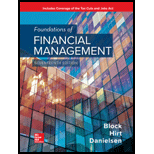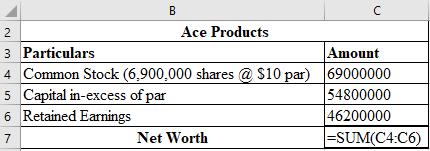
Concept explainers
a.
To show: The adjustments to be made in the capital account of Health Systems Inc. in order to pay a stock dividend of 15%.
Introduction:
Stock Dividend:
When a company pays dividend to its shareholders in the form of additional shares, it is termed as stock dividend. This form is generally paid when the company has less cash reserves.
a.
Answer to Problem 19P
The adjustments that would be made to the capital account for the payment of 10% stock dividend are as follows.

Explanation of Solution
The formula used for making the required adjustments to the capital account is shown below.

Working Notes:
Calculation of stock dividend in numbers:
Calculation of additional capital in excess of par:
Calculation of capital in excess of par:
Calculation of the closing balance of the
b.
To show: The adjustments to be made to the EPS as well as stock price of Health Systems Inc., keeping the P/E ratio constant.
Introduction:
Earnings per share (EPS):
It is the profit earned by shareholders on each share. A higher EPS indicates a higher value of the company because investors are ready to pay a higher price for one share of the company.
Stock Price:
The highest price of a share of a company that an investor is willing to pay is termed as the stock price. It is the current price used for the trading of such shares.
b.
Answer to Problem 19P
The EPS of Health Systems Inc. after stock dividend is $2.78 and the price of its stocks is $27.80.
Explanation of Solution
Calculation of the EPS of Health Systems Inc. after stock dividend:
Calculation of the price of stock:
Working Note:
Calculation of the number of shares after stock dividend:
c.
To calculate: The number of shares a shareholder would have if they originally owned 80 shares.
Introduction:
Stockholder:
Also called shareholders, people who own shares or capital stock in a corporation are known as stockholders. In other words, a shareholder is one who partly owns a company, that is, limited to the amount of shares owned.
c.
Answer to Problem 19P
The number of shares that a shareholder originally holding 80 shares will after the declaration of stock dividend is 92.
Explanation of Solution
Calculation of the number of shares of one of the shareholders after stock dividend:
d.
To calculate: The worth of the total investments of an investor before as well as after the stock dividend, keeping the P/E ratio constant.
Introduction:
Stock Dividend:
When a company pays dividend to its shareholders in the form of additional shares, it is termed as stock dividend. This form is generally paid out when the company has less cash reserves.
d.
Answer to Problem 19P
With the P/E ratio remaining constant, the worth of the total investments of an investor before the declaration of stock dividend is $2,560 and that after the stock dividend is $2,557.60.
Explanation of Solution
Calculation of the value of an investor’s total investments before the declaration of stock dividend:
Calculation of the value of an investor’s total investments after the declaration of stock dividend:
e.
To calculate: The worth of the total investments of an investor holding 80 shares after stock dividend.
Introduction:
Stock Dividend:
When a company pays dividends to its shareholders in the form of additional shares, it is termed as stock dividend. This form is generally paid out when the company has less cash reserves.
e.
Answer to Problem 19P
The worth of the total investments, after stock dividend, of an investor who owns 80 shares of the company prior to the same is $2,944.
Explanation of Solution
Calculation of the value of an investor’s total investments after the declaration of stock dividend:
f.
To determine: Whether the investor is better off in the scenario given in part (e).
Introduction:
Stock Dividend:
When a company pays dividends to its shareholders in the form of additional shares, it is termed as stock dividend. This form is generally paid out when the company has cash reserves.
f.
Answer to Problem 19P
Yes, the investor is better off in the scenario given in part (e).
Explanation of Solution
Since the cash dividend remains constant, the shareholder will receive more cash dividend along with a rise of $384 in the value of their portfolio of investments since 12 more shares at a value of $32 per share have been added.
g.
To calculate: The dividend yield on the stocks as per the scenario given in part (e).
Introduction:
Annual dividend yield:
Also termed as dividend price ratio, it is the ratio that helps compare the annual dividend of a company to its share price.
g.
Answer to Problem 19P
The dividend yield for Health Systems Inc. on the stocks as per the scenario given in part (e) is 3.91%.
Explanation of Solution
Calculation of the dividend yield:
Want to see more full solutions like this?
Chapter 18 Solutions
EBK FOUNDATIONS OF FINANCIAL MANAGEMENT
- Describe in detail what exactly is the Cash Conversion Cycle, how is it computed and what is the purpose of this calculation (how is it used).arrow_forwardExplain what Interest Rate Parity is, how it is calculated, and why it is important to a company operating internationally.arrow_forwardCompare and contrast the three core means of adding shareholder wealth; Cash Dividends, Stock Dividends and Stock Splits, and Stock Repurchases. Include the various advantages and disadvantages of each one.arrow_forward
- Calculate the future value of a lump sum of $1,000 invested for 4 years at 10%, using compounded quarterly.arrow_forwardIf value is not clear then please comment i will write values dont solve question, i will give unhelpful.arrow_forwardwhat are some of the question can i asek my prinsiple of finance teache?arrow_forward
- A critical discussion of the hockey stick model of start-up financing should be presented, supported by recent in-text citations. Provide a detailed explanation of the model. Describe each of the three stages of the hockey stick model of start-up financing, including a detailed characterisation of each stage. The characterisation of each stage should detail the growth, risk, and funding expectations. Present a critical evaluation and an insightful conclu sion.arrow_forwardQuestion Workspace Check My Work New-Project Analysis The president of your company, MorChuck Enterprises, has asked you to evaluate the proposed acquisition of a new chromatograph for the firm's R&D department. The equipment's basic price is $64,000, and it would cost another $18,000 to modify it for special use by your firm. The chromatograph, which falls into the MACRS 3-year class, would be sold after 3 years for $28,400. The MACRS rates for the first three years are 0.3333, 0.4445 and 0.1481. (Ignore the half-year convention for the straight-line method.) Use of the equipment would require an increase in net working capital (spare parts inventory) of $3,000. The machine would have no effect on revenues, but it is expected to save the firm $24,760 per year in before-tax operating costs, mainly labor. The firm's marginal federal-plus-state tax rate is 25%. Cash outflows and negative NPV value, if any, should be indicated by a minus sign. Do not round intermediate…arrow_forwardAlthough the Chen Company's milling machine is old, it is still in relatively good working order and would last for another 10 years. It is inefficient compared to modern standards, though, and so the company is considering replacing it. The new milling machine, at a cost of $108,000 delivered and installed, would also last for 10 years and would produce after-tax cash flows (labor savings and depreciation tax savings) of $19,000 per year. It would have zero salvage value at the end of its life. The project cost of capital is 11%, and its marginal tax rate is 25%. Should Chen buy the new machine? Do not round intermediate calculations. Round your answer to the nearest cent. Negative value, if any, should be indicated by a minus sign.arrow_forward
 Managerial Accounting: The Cornerstone of Busines...AccountingISBN:9781337115773Author:Maryanne M. Mowen, Don R. Hansen, Dan L. HeitgerPublisher:Cengage Learning
Managerial Accounting: The Cornerstone of Busines...AccountingISBN:9781337115773Author:Maryanne M. Mowen, Don R. Hansen, Dan L. HeitgerPublisher:Cengage Learning EBK CONTEMPORARY FINANCIAL MANAGEMENTFinanceISBN:9781337514835Author:MOYERPublisher:CENGAGE LEARNING - CONSIGNMENT
EBK CONTEMPORARY FINANCIAL MANAGEMENTFinanceISBN:9781337514835Author:MOYERPublisher:CENGAGE LEARNING - CONSIGNMENT Cornerstones of Financial AccountingAccountingISBN:9781337690881Author:Jay Rich, Jeff JonesPublisher:Cengage Learning
Cornerstones of Financial AccountingAccountingISBN:9781337690881Author:Jay Rich, Jeff JonesPublisher:Cengage Learning Pfin (with Mindtap, 1 Term Printed Access Card) (...FinanceISBN:9780357033609Author:Randall Billingsley, Lawrence J. Gitman, Michael D. JoehnkPublisher:Cengage Learning
Pfin (with Mindtap, 1 Term Printed Access Card) (...FinanceISBN:9780357033609Author:Randall Billingsley, Lawrence J. Gitman, Michael D. JoehnkPublisher:Cengage Learning



